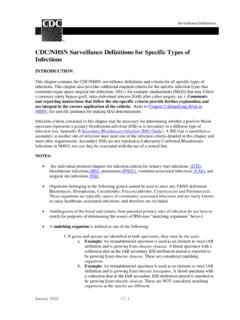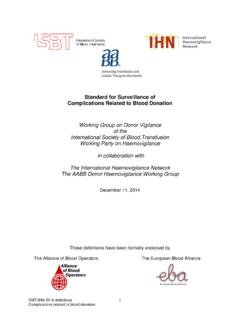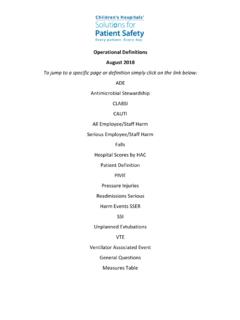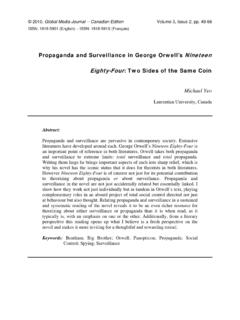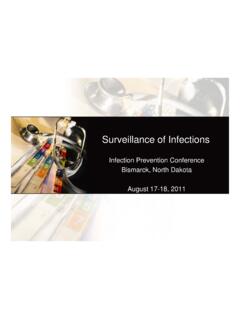Transcription of Bloodstream Infection Event (Central Line-Associated ...
1 4-1 January 2018 Device-associated Module BSI Bloodstream Infection Event (Central Line-Associated Bloodstream Infection and Non-central Line Associated Bloodstream Infection ) Table of Contents Bloodstream Infection Event (Central line and non-central Line-Associated BSI: Introduction and settings. 3 Key Terms and Abbreviations (universal) 3 Definitions specific to BSI / CLABSI surveillance: 3-5 Devices that are Not Central Lines 6 Table 1: Laboratory Confirmed Bloodstream Infection Definitions: LCBI 1, LCBI 2, LCBI 3 7-9 Table 2: Mucosal Barrier Injury LCBI (MB-LCBI) Combined table 10 Comments and Reporting Instructions 11-14 Blood specimen collection 14 Making Determinations about Device Day Counts and Device Association: Examples for Table 3 15 Table 3: Associating the Use of Central Lines to BSI Events (CLABSI) 16 Rationale for Table 3 17 Pathogen Exclusions and Reporting Considerations 17-18 Table 4: Reporting Speciated and Unspeciated Organisms from Blood Specimens 18 Table 5: Examples Illustrating the MBI-LCBI Criteria for Neutropenia.)
2 (Rationale) 19 Monthly Summary Data (numerator data, reporting instruction, denominator data, collection methods) 20-22 Table 6: CLABSI Measures Available in NHSN 20 Data Analysis 23 4-2 January 2018 Device-associated Module BSI References 25 Appendix A: Partial List of Criterion 1 MBI-LCBI Eligible Enterobacteriaceae Genera 26 Appendix B. Secondary BSI Guide 27 Making Secondary BSI Determinations: Secondary BSI Scenarios 26-29 Table B1: Secondary BSI Guide 30 Secondary BSI Reporting Instructions 31 Matching Organisms 31-32 Pathogen Assignment (Examples) 33-35 Figure B1: Secondary BSI Guide for Eligible Organisms (NEC Exception) 36 Figure B2: VAE Guidance for Secondary BSI Determination 37 4-3 January 2018 Device-associated Module BSI Introduction: Although a 46% decrease in CLABSIs has occurred in hospitals across the from 2008-2013, an estimated 30,100 central Line-Associated Bloodstream infections (CLABSI) still occur in intensive care units and wards of acute care facilities each CLABSIs are serious infections typically causing a prolongation of hospital stay and increased cost and risk of mortality.
3 CLABSI can be prevented through proper insertion techniques and management of the central line. These techniques are addressed in the CDC s Healthcare Infection Control Practices Advisory Committee (CDC/HICPAC) Guidelines for the Prevention of Intravascular Catheter-Related Infections, Settings: Surveillance may occur in any inpatient location where denominator data can be collected, which can include critical/intensive care units (ICU), specialty care areas (SCA), neonatal units including neonatal intensive care units (NICUs), step down units, wards, and long term care units. A complete listing of inpatient locations and instructions for mapping can be found in the CDC Locations and Descriptions chapter. Note: CLABSI surveillance after patient discharge from a facility is not required. However, if discovered, any CLABSI with a date of Event (DOE) on the day of or the day after discharge is attributed to the discharging location and should be communicated to that facility to encourage appropriate NHSN reporting of CLABSIs.
4 (See Transfer Rule, Chapter 2). Do not collect or report additional central line days after discharge. Key Terms and Abbreviations Refer to the NHSN Patient Safety Manual, Chapter 2 Identifying Healthcare Associated Infections in NHSN and Chapter 16 NHSN Key Terms for definitions of the following universal concepts for conducting HAI surveillance. I. Date of Event (DOE) II. Healthcare associated Infection (HAI) III. Infection window period (IWP) IV. Present on admission (POA) V. Repeat Infection timeframe (RIT) VI. Secondary BSI attribution period (SBAP) VII. Location of Attribution (LOA) VIII. Transfer rule Definitions specific to BSI / CLABSI Surveillance: Primary Bloodstream Infection (BSI): A Laboratory Confirmed Bloodstream Infection (LCBI) that is not secondary to an Infection at another body site (see Appendix B. Secondary BSI Guide and CDC/NHSN Surveillance Definitions for specific types of Infection [Ch-17], UTI [Ch-7], Pneumonia (Ch-6), and SSI (Ch-9).)
5 4-4 January 2018 Device-associated Module BSI LCBI Hierarchy; types of LCBIs (s ee Table 1 and Table 2): Secondary BSI: A BSI that is thought to be seeded from a site- specific Infection at another body site (see Appendix B. Secondary BSI Guide and CDC/NHSN Surveillance Definitions for specific types of Infection [Ch-17], UTI [Ch-7], Pneumonia (Ch-6), and SSI (Ch-9). Secondary BSI Attribution Period (SBAP): the period in which a blood specimen must be collected for a secondary BSI to be attributed to a primary site of Infection . This period includes the Infection Window Period (IWP) combined with the Repeat Infection Timeframe (RIT). It is 14-17 days in length depending upon the date of Event (see Ch. 2 page 2-13). Infusion: The administration of any solution through the lumen of a catheter into a blood vessel. Infusions include continuous infusion (for example, nutritional fluids or medications), intermittent infusion (for example, IV flush), IV antimicrobial administration, and blood transfusion or hemodialysis treatment.)
6 Access: The performance of any of the following activities during the current inpatient admission: Line placement Use of (entering the line with a needle or needless device) any central line for:oInfusionoWithdrawal of blood Use for hemodynamic : a patient is admitted to a an inpatient location with a central line (CL) already in place, and itis the patient s only CL, the day of first access in an inpatient location begins the device daycount as CL Day 1 for making device-associated determinations. Note: simply de-accessing acentral line (for example, removal of port needle but port remains in body) does not result in thepatient s removal from CLABSI surveillance nor from including the central line in central lineday 1 MBI-LCBI 1 LCBI 2 MBI-LCBI 2 LCBI 3 MBI-LCBI 34-5 January 2018 Device-associated Module BSI inpatient location, for making determinations about central line access, includes but is notlimited to, any department or unit within the facility that provides service to inpatients [forexample, inpatient Dialysis, Operating Room (OR), Interventional Radiology, GastroenterologyLab (GI), Cardiac Catheterization lab (CC), wards, ICUs, etc.]
7 ]. any inpatient receiving dialysis in CLABSI surveillance conducted in the patient sassigned inpatient location, regardless of whether or not the patient only has one CL and dialysisstaff are the only providers to access it during dialysis : CLABSIs in the following examples will be attributed to Unit A Patient on Unit A receives onsite dialysis by contracted dialysis staff Dialysis staff travels to Unit A to provide dialysis to Unit A patient Patient in Unit A for inpatient care is transported to dialysis unit within the facility fordialysisBecause CLABSI events cannot be attributed to a non-bedded location, such events must be attributed to the inpatient location housing the patient. Central line (CL): An intravascular catheter that terminates at, close to the heart, OR in one of the great vessels that is used for infusion, withdrawal of blood, or hemodynamic monitoring.
8 Consider the following great vessels when making determinations about CLABSI events and counting CL device days: Aorta Pulmonary artery Superior vena cava Inferior vena cava Brachiocephalic veins Internal jugular veins Subclavian veins External iliac veins Common iliac veins Femoral veins In neonates, the umbilical : the type of device nor the insertion site are used to determine if a device is considered acentral line for NHNS reporting times, a CL may migrate from its original central location after confirmation of properplacement. NHSN does not require ongoing verification of proper line placement. Therefore,once a line has been designated a CL it continues to be a CL, regardless of migration, untilremoved from the body or patient discharge, whichever comes first. CL days are included indevice-day counts for any CLABSI surveillance conducted in that location.
9 4-6 January 2018 Device-associated Module BSI 3. An introducer is an intravascular catheter, and depending on the location of the tip and its use, may be considered a CL. 4. A non-lumened intravascular catheter that terminates at or close to the heart or in a great vessel that is not used for infusion, withdrawal of blood or hemodynamic monitoring is not considered a CL for NHSN reporting purposes (for example, non-lumened pacemaker wires. Please note: there are some pacemaker wires that do have lumens, which may be considered a central line). types of Central Lines for NHSN reporting purposes: 1. Permanent central line: Includes: a. Tunneled catheters, including tunneled dialysis catheters b. Implanted catheters (including ports) 2. Temporary central line: A non-tunneled, non-implanted catheter 3. Umbilical catheter: A vascular catheter inserted through the umbilical artery or vein in a neonate.
10 All umbilical catheters are central lines. Eligible Central Line: A CL that has been in place for more than two consecutive calendar days (on or after CL day 3), following the first access of the central line, in an inpatient location, during the current admission. Such lines are eligible for CLABSI events and remain eligible for CLABSI events until the day after removal from the body or patient discharge, whichever comes first. See Table 3 for examples Central Line-Associated BSI (CLABSI): A laboratory confirmed Bloodstream Infection where an eligible BSI organism is identified and an eligible central line is present on the LCBI DOE or the day before. Eligible BSI Organism: Any organism that is eligible for use to meet LCBI or MBI-LCBI criteria. In other words, an organism that is not an excluded pathogen for use in meeting LCBI or MBI-LCBI criteria.










